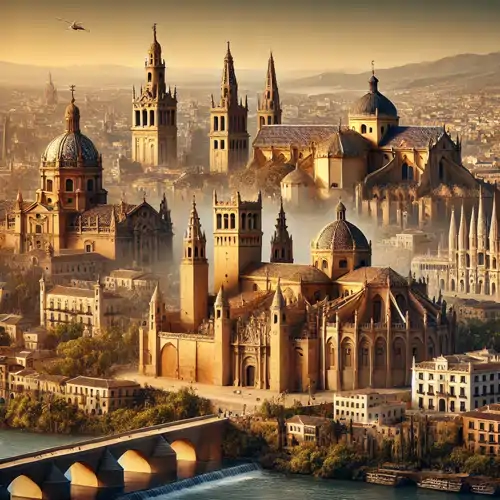Introduction
Spain – is a country with a centuries-old history, rich culture and outstanding architecture. For travelers interested in architectural masterpieces, the main problem is the choice of places to visit, as well as understanding their historical significance and influence on modernity. This article examines the 10 main architectural monuments that combine elements of Moorish, Gothic, Renaissance and Modernist styles. The keywords used - Spain, architecture, masterpieces, history, culture, heritage - reflect the essence of the material.
1. Alhambra (Palace of palaces and gardens of the Alhambra)
The Alhambra in Granada is one of the most famous monuments of Islamic architecture in Europe. It is a complex of palaces and gardens built by the Moors during their rule in Spain. The main feature is the Lion Courtyard, which served as the center of the palace ensemble. Here you can see a unique combination of decorative ornaments, exquisite carvings and engineering solutions characteristic of Moorish art. The Alhambra demonstrates how art and functionality intertwine in architecture, creating a space where history becomes a living heritage.
2. Basilica of the Sagrada Familia (Sagrada Família)
The Basilica of the Sagrada Familia in Barcelona is an iconic project by Antoni Gaudí that combines elements of modernism and traditional architectural forms. The fame of this temple is due not only to its scale, but also to its original towers, each of which represents a unique architectural experiment. Despite the fact that construction has been ongoing since 1882, the site has already attracted the attention of millions of tourists, becoming a symbol of the city and an example of an innovative approach to architecture.
3. Mosque of Cordoba
The Mosque of Cordoba, originally built as a mosque, is one of the best examples of the synthesis of Islamic and Christian architecture. After the conquest of the territory by Christians, the building was converted into a Roman Catholic cathedral. This architectural ensemble is distinguished by a magical forest of columns, arches with elements of Arabic calligraphy and exquisite carvings, which allows you to see the centuries-old intertwining of cultures and traditions in one monument.
4. Cathedral of Santiago de Compostela
Santiago de Compostela is the end point of the famous pilgrimage route known as the Camino de Santiago. The cathedral of this city has not only religious but also historical significance. Its architecture reflects the traditions of medieval Europe and is a testament to the continuity of generations. For those who are looking not just for a landmark, but a place with a deep symbolic meaning, this cathedral offers an opportunity to immerse themselves in the history of Spain's Christian heritage. We recommend that you take a guided tour of the cathedral's roof.
5. Burgos Cathedral
Burgos Cathedral is the only site on the UNESCO World Heritage List. This Gothic monument is distinguished by its strict forms, imposing dimensions and rich decoration. Its architectural design demonstrates the great skill of medieval architects and is a clear example of how religious ideas are reflected in stone and glass.
6. Alcazar of Segovia
The Alcazar of Segovia is a shining example of medieval military architecture. Built on a rock, it served as a residence for Spanish kings, and its design allowed the use of natural landscape elements for defensive purposes. The architectural diversity of the castle, from its powerful walls to the decorative elements of its interior, makes it an important historical monument that can reveal the evolution of architectural technologies of the past.
7. Cathedral of Palma de Mallorca
This cathedral attracts attention not only for its scale, but also for its multicolored rosette and its chapel, designed by Miquel Barceló. The building is a shining example of how religious architecture can combine aesthetic and functional elements, creating a harmonious unity of tradition and innovation. For travelers looking for unique architectural solutions, the Cathedral of Palma de Mallorca is a must-see.
8. Basilica of Our Lady of the Pillar
Located in Zaragoza, the Basilica of Our Lady of the Pillar stands out for its imposing facade and rich interior decoration. This building is not only an important religious center, but also shows the evolution of the architectural style of the region. The interior, made with decorative elements and traditional materials, allows you to feel the cultural heritage of Spain and its religious traditions.
9. Roman Theater of Merida
The Roman Theater of Merida is one of the oldest surviving monuments, built in the 1st century BC. Despite its antiquity, the theater continues to be used for cultural events, which demonstrates its durability and functionality. Its capacity for 3,000 spectators confirms the scale and importance of this architectural structure, which is a living testament to the Roman influence in Spain.
10. The Giralda
The Giralda in Seville, originally built as a minaret, now serves as the bell tower of the cathedral. Its architectural design combines elements of Islamic and Christian cultures, reflecting the historical transition of power and cultural exchange. The tower has become a symbol of the city, and the panoramic view from its upper levels allows you to appreciate the beauty of the historic center of Seville from above.
Conclusion
The analysis of the presented architectural monuments shows that each of them is not only a monument of art, but also a practical guide for travel planning. Spanish architecture reflects the complex intertwining of historical periods and cultural influences, which allows tourists not only to enjoy the visual beauty, but also to better understand the evolution of engineering and artistic solutions. For those who are faced with the problem of choosing a route, the article offers a clear scheme: from the Moorish ensembles to the Gothic and Renaissance buildings, all sites are united by the common idea of preserving cultural heritage.
Using the keywords - Spain, architecture, masterpieces, history, culture, heritage - the reader gets a complete picture of the importance of each monument. The practical conclusion is as follows: when planning a cultural route, it is worth paying attention not only to the appearance of the buildings, but also to historical facts, construction technologies and the way of preserving traditions, which makes each visit truly informative and useful.








